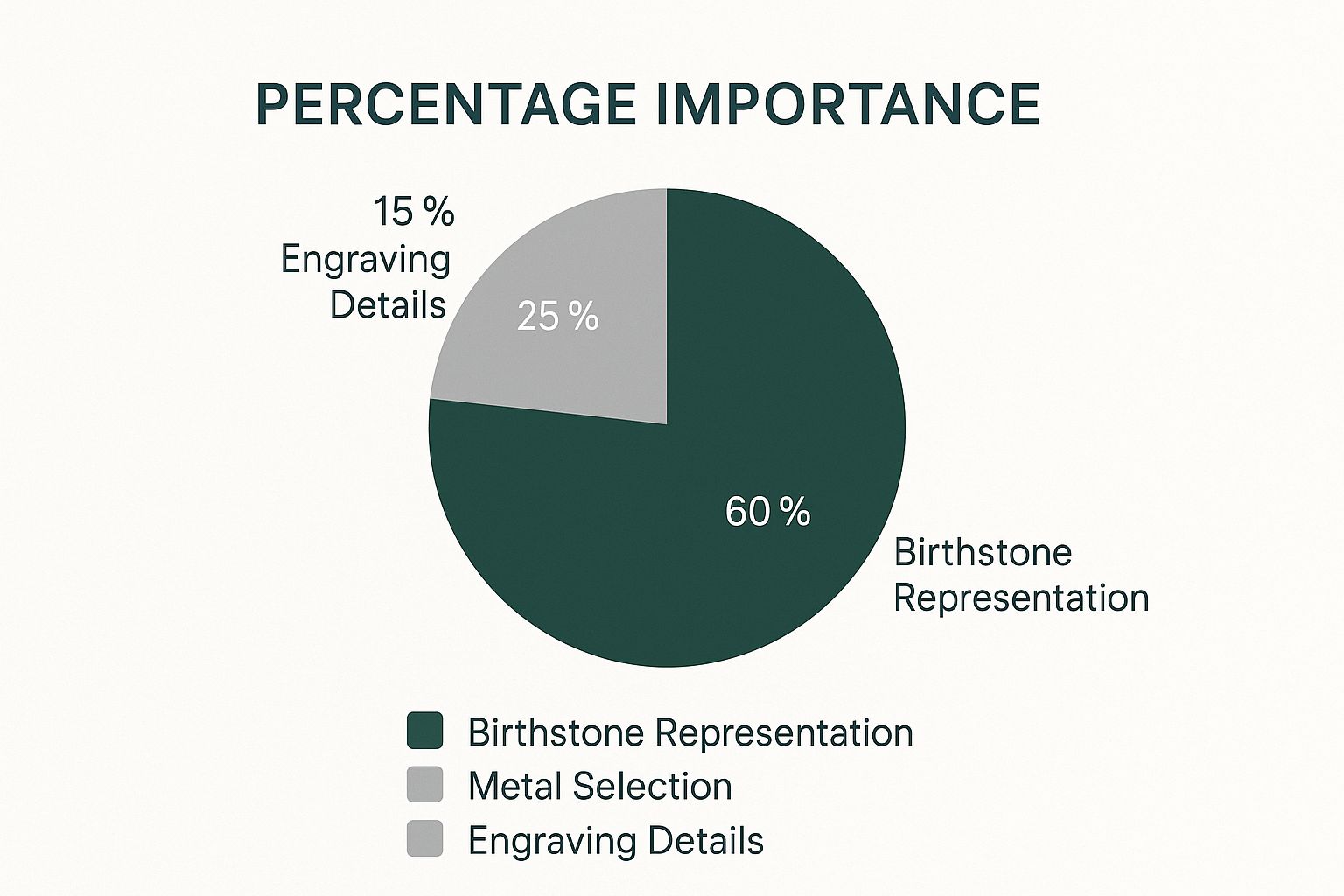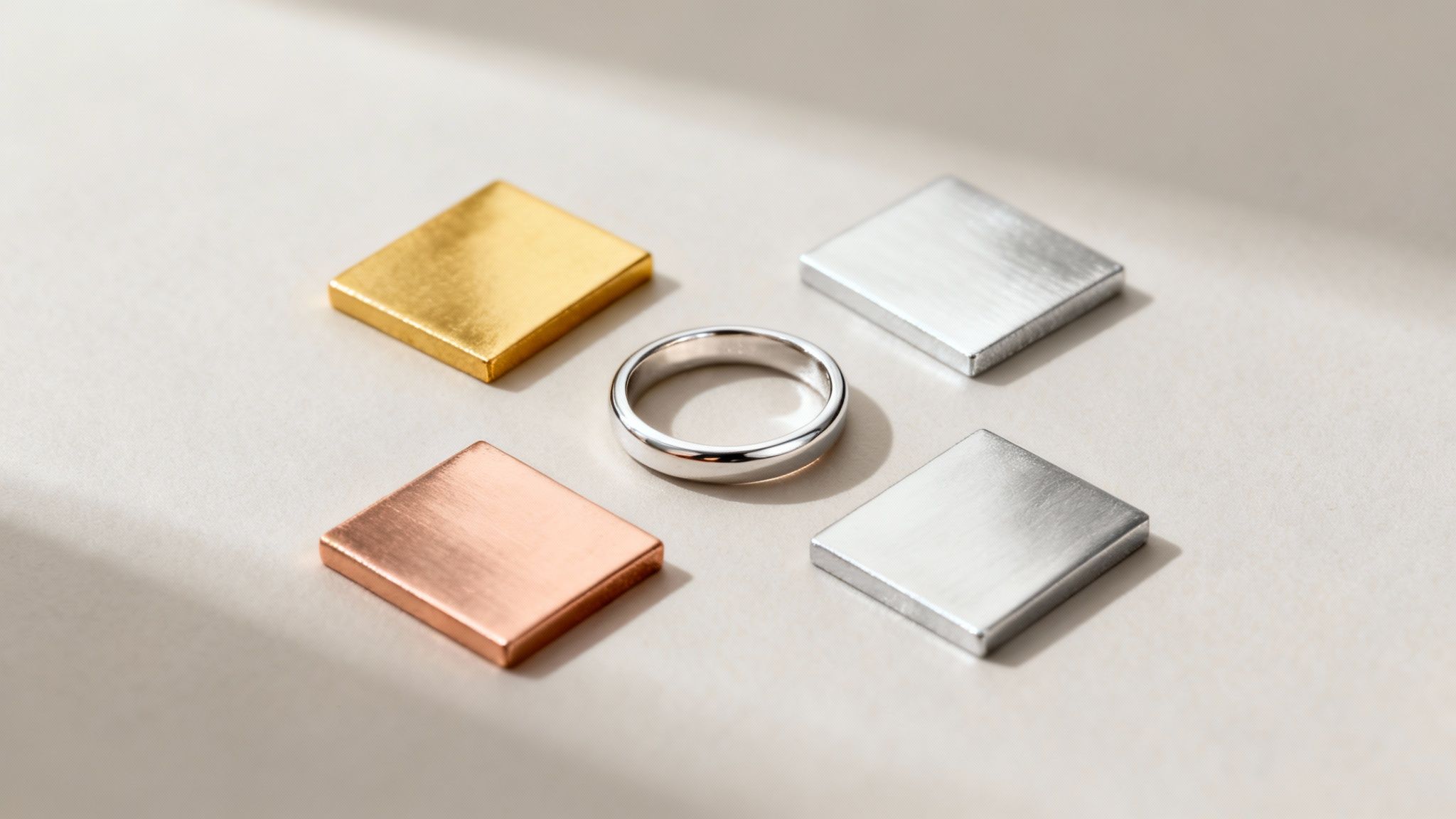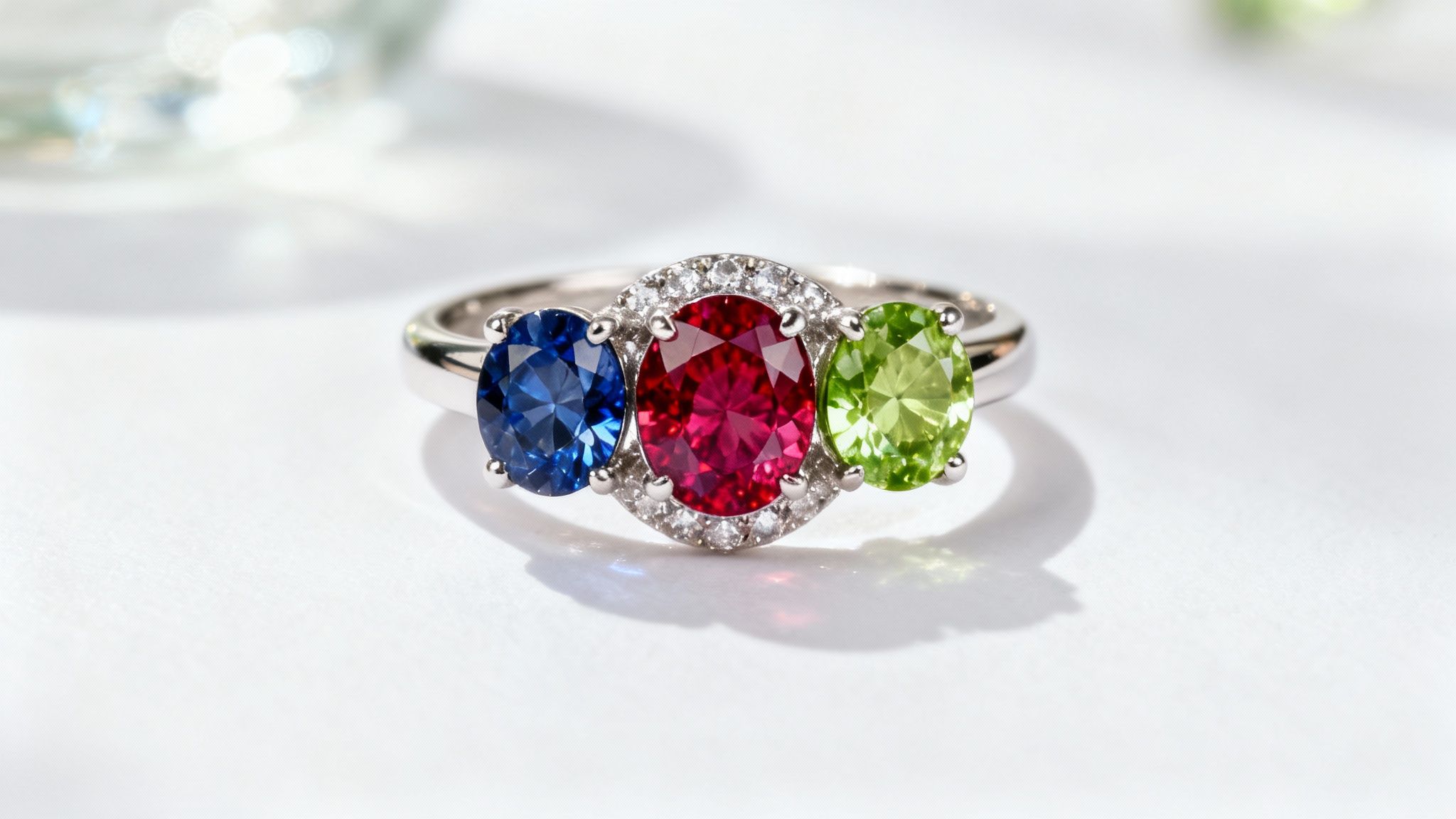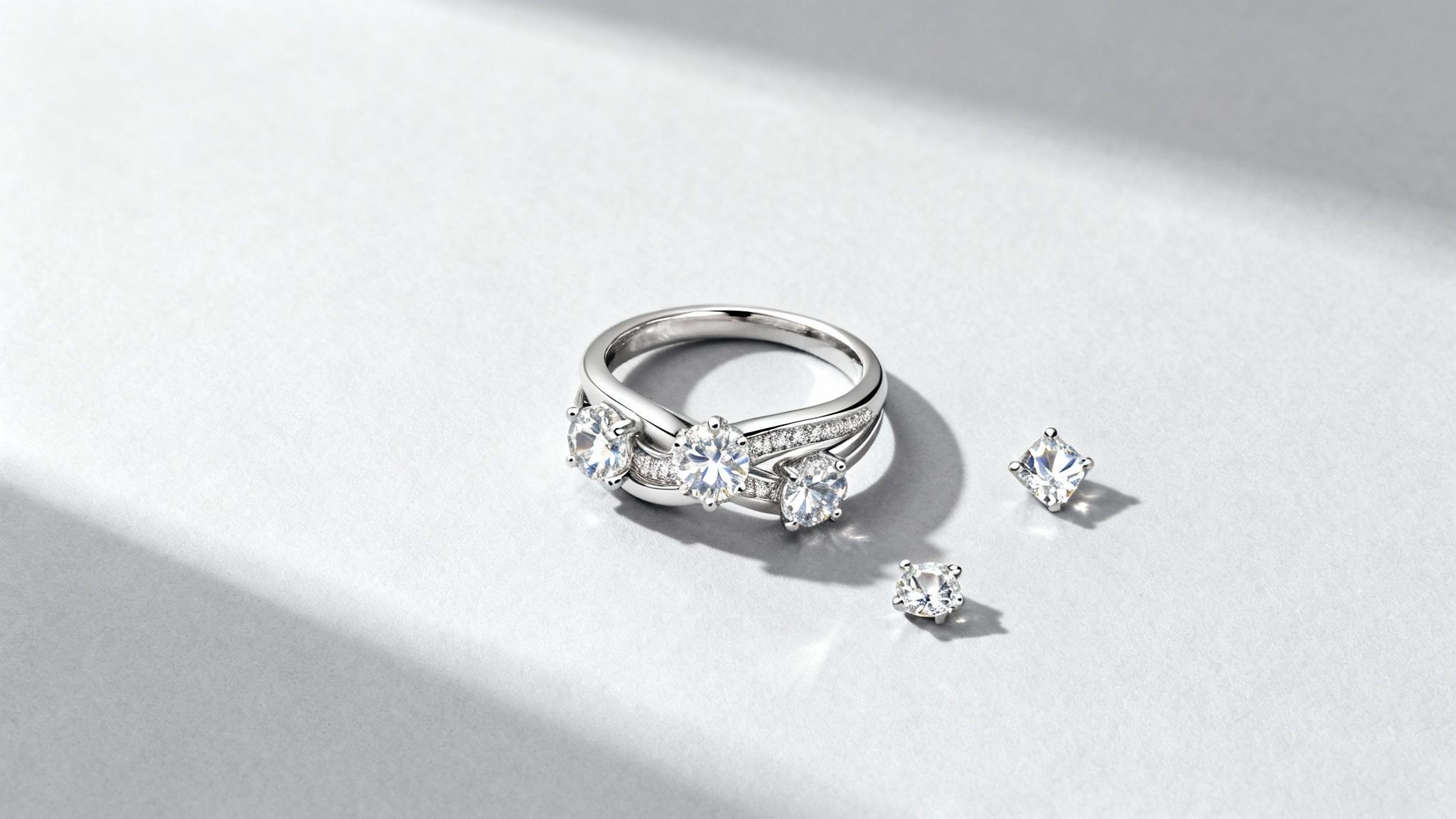- Continue Shopping
- Your Cart is Empty
Designing a Mothers Ring That Tells a Story
Designing a mother's ring isn't just about picking out some pretty stones. It's about telling a story—your family's story—and turning it into a beautiful piece of art she can wear every day. It's a blend of meaningful birthstones, strong metals, and those little personal touches that make it hers alone.
Let’s walk through how to make those choices with confidence.
Crafting a Ring as Unique as Your Family
Creating a mother's ring is a truly personal journey. You’re not just buying another piece of jewelry; you're crafting a tangible symbol of your family's bond, something that captures memories and relationships in one place. The whole point is to create something that not only fits her style but is also built to last through daily life, telling her story with every glance.
To get there, we need to focus on a few key elements that come together to make the design work:
- Birthstone Symbolism: This is the heart of the ring. It's all about choosing the right gems to represent each child, and maybe even the parents or grandparents.
- Metal and Setting Durability: Think of this as the foundation. We need to choose a metal and setting that can handle her lifestyle, ensuring this ring becomes a true heirloom.
- Personalized Details: This is where the magic happens. Engravings, unique finishes, or special arrangements add that final, sentimental layer that makes the ring exclusively hers.
Focusing on What Matters Most
While every detail plays a part, some elements naturally take center stage. This infographic really breaks down what people prioritize when they're designing a mother's ring.

As you can see, it's all about the birthstones. That’s the core purpose of the ring, after all—to be a tribute to her family.
The desire for meaningful, custom jewelry is only getting stronger. Just look at Mother's Day, where jewelry spending is projected to reach a staggering $6.8 billion. With 42% of shoppers specifically looking for jewelry, it's clear that people crave these personal, heartfelt gifts.
If you're looking for a little inspiration, it never hurts to look at the masters of fine jewelry. Exploring the artistry of iconic brands can spark some amazing ideas. For instance, reviewing Van Cleef & Arpels' exquisite jewelry creations can give you a feel for classic stone arrangements and timeless elegance. And if you want to explore this topic further, our guide on https://www.efytal.com/blogs/outrank-blog/personalized-family-jewelry is a great place to start.
Choosing the Right Metal and Setting for Daily Wear

While the birthstones beautifully tell the family story, it’s the metal and setting that serve as the foundation, holding everything together. When you’re designing a mother's ring, these structural choices are everything—they determine how the ring looks and, more importantly, how well it lasts.
The real key is to match the ring's materials to her actual life. Think about her daily routine. Is she an avid gardener with her hands in the dirt? A nurse constantly washing her hands? Or does she spend her days at a desk? A ring she'll wear every day needs to handle the inevitable bumps, scrapes, and hand-washing that come with a busy life.
This is where your metal choice becomes a deeply practical decision, not just a cosmetic one.
A Look at Popular Metal Choices
Every precious metal has its own personality, offering a unique mix of beauty, strength, and upkeep. Getting to know their differences is the best way to feel confident in your decision.
Here’s a breakdown of the most common options:
- Yellow Gold (14k or 18k): You can't go wrong with this timeless classic. Yellow gold has a warm, traditional glow that never goes out of style. We often recommend 14k gold because it hits that sweet spot between rich color and solid durability, making it perfect for daily wear.
- White Gold: For a sleek, modern look, white gold is a fantastic choice. It gets its silvery-white shine from being mixed with other white metals and then coated with a layer of rhodium. That rhodium plating will need to be reapplied every few years to keep it looking bright, but for many, it's a small price to pay for its contemporary appeal.
- Rose Gold: This romantic, pink-hued metal gets its beautiful color from a copper alloy. It has a lovely vintage feel and is surprisingly durable, making it both a stylish and practical pick.
- Platinum: When it comes to pure strength, platinum is the undisputed champion. It's incredibly dense, tough, and naturally hypoallergenic. For someone with a very active lifestyle or known metal allergies, this is the most resilient choice you can make, though it does sit at a higher price point.
If skin sensitivity is a big concern, platinum is a safe bet. But don't rule out other metals just yet! Understanding the alloys is key. You can dive deeper into this topic with our guide to hypoallergenic jewelry.
To make it even easier, here's a simple comparison of these popular metals.
Comparing Popular Metals for a Mothers Ring
This table compares the characteristics of common precious metals to help you choose the best foundation for your custom ring.
| Metal Type | Color | Durability/Hardness | Common Maintenance | Price Point |
|---|---|---|---|---|
| Yellow Gold | Classic Yellow | Good durability, especially 14k; softer than platinum | Regular cleaning; polishing to remove scratches | Mid-Range |
| White Gold | Silvery White | Strong, but the rhodium plating can wear off over time | Re-plating with rhodium every 1-3 years is common | Mid-Range |
| Rose Gold | Warm Pink | Very durable due to the copper alloy content | Polishing to maintain its unique luster | Mid-Range |
| Platinum | Bright White | Extremely durable and dense; it bends but rarely breaks | Scratches can be polished out; needs no re-plating | Higher-End |
Choosing a metal is a balance of aesthetics, lifestyle, and budget. Each one can create a stunning ring, so it's all about finding the perfect fit for the person who will be wearing it.
How the Setting Protects the Gemstones
A setting does so much more than just hold the stones in place. Think of it as the ring's built-in security system, protecting the precious gems from the hazards of daily life.
A well-chosen setting is like a bodyguard for your gemstones. It should complement the stones' beauty while providing the structural integrity needed to prevent loss or damage over years of loving wear.
Here are a few of the most popular setting styles and what they’re best for:
- Prong Setting: This is the quintessential ring setting. It uses tiny metal claws to grip each gemstone, lifting it up to catch the most light and create maximum sparkle. It’s a beautiful look, but those prongs can occasionally snag on sweaters and may need to be checked and tightened by a jeweler over the years.
- Bezel Setting: A fantastic choice for security and modern style. A bezel setting wraps the gemstone in a thin, custom-fit metal rim. This provides excellent protection from bumps and is an especially smart choice for softer, more delicate birthstones.
- Channel Setting: Perfect for a smooth, sleek design. In a channel setting, stones are set right next to each other inside a grooved metal channel. There's no metal between the stones, creating an elegant, unbroken line of sparkle. It’s very secure and won’t snag on anything, making it ideal for mothers who are always on the go.
Selecting Birthstones That Tell Your Family Story

The heart and soul of any mother's ring are the birthstones. Each little gem is a stand-in for a person you love, so choosing them is about more than just matching a birth month to a chart. You're really crafting a color story that reflects your unique family.
Think of it as capturing a bit of each person’s spirit. That deep blue sapphire for a September baby isn’t just a pretty stone; it can represent their quiet wisdom. And a fiery ruby for a July child? It might just capture their bold, energetic personality perfectly. When you see the gems this way, the ring becomes so much more than jewelry—it’s a story you can wear.
If you want to dig deeper into the symbolism, we have a guide that explores what birthstones mean, covering their history and traditional meanings.
Handling Shared Birth Months
So, what happens when two kids share the same birth month? It’s a common situation, and a great chance to get creative. If you have two August babies, for instance, you don't have to just stick two identical green stones side-by-side.
Here are a couple of ways jewelers often handle this:
- Play with Shades: Peridot, the August birthstone, isn’t just one shade of green. It can range from a bright, zesty lime to a much deeper olive tone. Using two different shades is a subtle but beautiful way to give each child their own distinct spot on the ring.
- Use Alternate Stones: Many months actually have more than one official birthstone. August’s alternate is the spinel, which comes in a whole rainbow of colors. You could use a classic peridot for one child and a beautiful red or blue spinel for the other.
The key is to make every choice feel intentional. Differentiating stones for shared months adds a thoughtful layer of detail and makes the ring’s story even richer.
Practicality Meets Beauty: Gemstone Durability
While you’re lost in the beautiful symbolism of it all, there's a practical side to consider: durability. This ring is meant to be worn, loved, and lived in for years, so the stones need to be up to the task. We measure a gem's toughness on the Mohs scale of hardness, which goes from 1 (the softest) to 10 (the hardest).
A diamond, famous for its resilience, sits at a perfect 10. Right behind them are sapphires and rubies, which score a 9. These are fantastic choices for a ring that will see daily wear and tear.
On the other end of the spectrum, you have softer gems like pearls (2.5-4.5) or opals (5.5-6.5). They're absolutely gorgeous but are much more prone to scratches and chips. That doesn't mean you have to rule them out, but it’s something to keep in mind, especially if this ring is for someone with a very active lifestyle or hands-on job. A bezel setting, which wraps the edge of the stone in metal, can offer some much-needed protection for these more delicate options.
Considering a stone's durability from the get-go is what makes the difference between a beautiful ring and a lasting family heirloom. It’s that little bit of foresight that ensures the piece will stay stunning for generations.
Finding the Perfect Gemstone Arrangement
You’ve hand-picked the birthstones, with each gem holding a special place for a beloved family member. Now for the fun part: arranging them into a design that’s not just beautiful, but tells your family’s unique story. The layout you choose is where the ring truly comes to life.
There's no single "right" way to do this. It’s all about finding a style that captures the family's spirit and, most importantly, the mother's personal taste. The arrangement is what elevates the ring from a simple collection of stones into a thoughtful, cohesive piece of art.
Exploring Common Layout Strategies
The way you place each stone can say so much. Some families I've worked with love a linear narrative that clearly shows how their family grew, while others are drawn to more symbolic or visually artistic designs. This is your chance to get creative and be really intentional with the final look.
Here are a few popular approaches real families use:
- Chronological Order: This is the most traditional and straightforward layout for a reason. Placing the stones in birth order, from the oldest child to the youngest, tells a clear story. It’s a classic choice—logical, heartfelt, and easy for anyone to understand at a glance.
- Symmetrical Balance: If she prefers a more formal and classic aesthetic, a symmetrical arrangement is perfect. This often means placing a key stone—like the mother's birthstone or a central child's—in the middle, with the other stones artfully balanced on either side. It just creates this wonderful sense of harmony and stability.
- Organic Cluster: A modern and increasingly popular choice is the cluster or "scatter" design. Stones are arranged in a more free-form, organic way, often mixing sizes and shapes. It can feel whimsical and artistic, like a beautiful little constellation of your loved ones.
Your gemstone arrangement is a visual metaphor. A bypass style, where the band sweeps around the stones, can symbolize two partners. A cluster can represent the beautiful, happy chaos of a full house.
Practical Tips for Different Family Sizes
The number of stones you're working with will definitely guide your design choices. A layout that looks stunning with three stones might feel crowded and overwhelming with seven.
For Smaller Families (2-3 Stones)
With fewer stones, you have the flexibility to go for bold, distinct designs. A three-stone ring, for instance, is a timeless choice that can represent past, present, and future, or perhaps two parents and a child. I also love the bypass style, where the band splits and gracefully wraps around two stones—a beautiful symbol of a union or the bond between a parent and child.

For Larger Families (4+ Stones)
When you have more stones, the goal is to create a design that feels cohesive, not cluttered.
- Channel Setting: A channel-set band is a fantastic option. The stones are nestled side-by-side in a sleek, clean row. It’s a very secure and snag-free design that looks incredibly elegant.
- Stackable Rings: Instead of trying to fit everything onto one band, why not create a stack of thinner rings? Each band can hold the birthstone for one or two children. This is a wonderfully modern approach that also makes it easy to add new rings as the family grows.
Ultimately, the best arrangement is the one that feels right for her. Don’t be afraid to play around with different concepts, sketch out a few ideas, and have a good conversation with your jeweler about what’s possible. This final touch is what makes the ring a perfect reflection of the family it celebrates.
Adding Meaningful Engravings and Final Details
Once you’ve settled on the perfect combination of metals and birthstones, it’s the final details that truly elevate the ring from a beautiful piece of jewelry to a cherished family heirloom. This is where you get to embed the little secrets and memories that make your family's story unique. Engravings and other finishing touches are the last, most personal layer of the design.
Think of an engraving as a hidden message meant just for her, a small whisper of love tucked inside the band. While initials and dates are timeless for good reason, this is your chance to get creative and capture something that speaks directly to your family's heart.
Creative Engraving Ideas
To make the engraving deeply personal, think about the little inside jokes, special places, or unique phrases that define your family. The goal is to choose something that will bring a smile to her face every single time she looks at it.
Here are a few ideas to get you started:
- Geographic Coordinates: Engrave the latitude and longitude of a meaningful location—the family home, the place you were married, or even the hospital where your first child was born.
- A Snippet of a Quote: Is there a line from a song, a poem, or a funny family saying that everyone knows by heart? A short phrase like "love grows here" can be incredibly powerful.
- Family Nicknames: Using the special names you have for the children is a wonderfully intimate touch. Seeing a beloved nickname etched in gold or platinum is a constant, heartwarming reminder.
- A Simple Drawing: Believe it or not, some jewelers can even engrave a small doodle, like a child's drawing of a heart or a symbol that represents a shared memory.
When you're picking a font, remember that legibility is key. A clean, simple script or block font is usually the best choice to ensure the message stays clear and readable for decades, especially in such a small space.
Finishing Touches Beyond Engraving
Personalization doesn't just stop with words. The texture and decorative elements on the band itself add so much character and style, pulling the whole design together to perfectly match her taste.
The global fine jewelry market, currently valued at around $348 billion, is a testament to how much people value unique, high-quality pieces. In fact, fine jewelry accounts for roughly 68% of this market, showing a clear preference for meaningful accessories that last a lifetime. You can find more insights on the expanding global jewelry industry and its trends.
Consider these popular finishing details to complete the look:
- Pavé Accents: A sprinkle of tiny pavé diamonds along the band can add a delicate sparkle that complements the main birthstones without stealing the show.
- Milgrain Edges: For a touch of vintage elegance, milgrain detailing is a fantastic choice. This classic technique adds a row of tiny metal beads to the band's edges, creating a beautiful, antique-inspired frame.
- Band Textures: A smooth, polished band is a timeless classic, but a unique texture can add a whole new dimension. A hammered finish gives off a rustic, artisanal vibe, while a brushed or matte finish offers a soft, contemporary look that also happens to be great at hiding minor scratches.
Questions to Ask Before Designing Your Mother's Ring
Creating a custom mother's ring is such a personal journey. It’s completely normal to have a few questions before you dive in. Thinking through things like your budget, future family plans, and who you'll work with will make the whole process smoother and ensure the final ring is absolutely perfect.
What Should I Expect to Spend on a Custom Ring?
Honestly, the price can swing from a few hundred dollars to several thousand. The cost is all about the materials you choose. A beautiful sterling silver ring with small, lab-created birthstones is a wonderfully affordable option, while a platinum band loaded with large, natural diamonds will obviously be a much bigger investment.
The price really boils down to three main things:
- The Metal: Platinum is top-of-the-line, followed by various karats of gold. Sterling silver and 14k gold-fill are fantastic choices if you're working with a tighter budget.
- The Stones: This is a big one. The cost depends on whether you choose natural or lab-grown gems, not to mention their size and overall quality.
- The Design's Complexity: A simple, elegant band is going to be less expensive than a highly detailed setting with intricate engravings or a halo of tiny accent stones.
My best advice? Figure out your budget before you start looking. When you talk to a jeweler, be upfront about your price range. A good designer will use that as a creative guide, showing you the best options that won't break the bank.
Can I Add More Birthstones Later On?
Yes, you absolutely can, but it’s a million times easier if you plan for it from the get-go. Some ring styles are practically designed to grow with your family, while others are incredibly difficult—or even impossible—to change without starting from scratch.
If you think you might be adding to your family one day, just tell your jeweler. They can steer you toward designs that are built for it. Stackable bands, for example, are a perfect solution. You just add a new band for each new baby! Thinking ahead like this saves a ton of time, money, and heartache compared to trying to add a stone to a fixed setting years later.
How Do I Find a Jeweler I Can Trust?
This is maybe the most important step. For a custom piece, you need a partner, not just a salesperson. I always tell people to start local. Look up jewelers in your area and spend some time looking through their online portfolios. You'll get a real sense of their style and the quality of their work.
Check for positive reviews and see if they have any credentials from places like the Gemological Institute of America (GIA). Once you have a shortlist, book a quick meeting with two or three of them. You'll know you've found the right person when they genuinely listen to your ideas, explain their process, and make you feel excited to create something special together.
How Long Does It Take to Make a Custom Ring?
You’ll want to plan for about four to eight weeks from start to finish. That window gives the jeweler enough time for everything—the first design chat, creating a 3D model for you to approve, casting the ring, setting each stone by hand, and giving it that final, perfect polish.
Of course, a really complex design might take a bit longer, and it also depends on how busy the jeweler is. If you're aiming for a specific date like Mother's Day, a birthday, or an anniversary, do yourself a favor and start the process at least two or three months early. It takes all the pressure off.
At EFYTAL Jewelry, we believe every family's story deserves to be told beautifully. Explore our collection of handcrafted, personalized keepsake pieces and let us help you design a ring she will treasure for a lifetime. Start creating your meaningful gift today at https://www.efytal.com.





